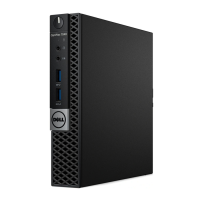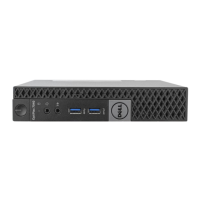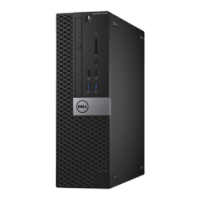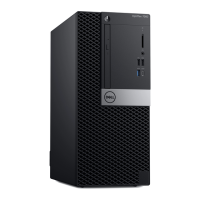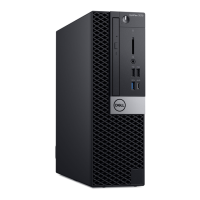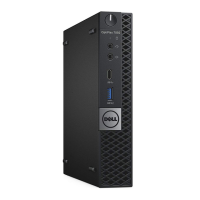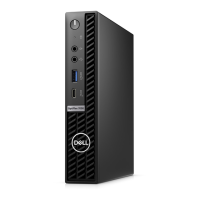Do you have a question about the Dell OptiPlex 7040 and is the answer not in the manual?
Defines the meaning of NOTE, CAUTION, and WARNING symbols used in the manual.
Safety guidelines and preparatory steps before accessing internal computer components.
Procedure for safely shutting down the computer before maintenance.
Steps to follow after internal work before powering on the computer.
Lists the tools required for performing component removal and installation.
Step-by-step guide to remove the computer's outer casing.
Steps to re-install the computer's outer casing.
Procedure to detach the front panel bezel from the computer.
Procedure to attach the front panel bezel to the computer.
Steps to remove the internal cooling fan duct.
Steps to install the internal cooling fan duct.
Procedure to remove RAM modules from the system board sockets.
Procedure to install RAM modules into the system board sockets.
Steps to disconnect and remove the chassis intrusion detection switch.
Steps to connect and install the chassis intrusion detection switch.
Procedure to remove an expansion card from its slot.
Procedure to install an expansion card into its slot.
Steps to remove the complete hard drive mounting assembly.
Procedure to detach a hard drive from its carrier bracket.
Procedure to mount a hard drive into its carrier bracket.
Steps to install the complete hard drive mounting assembly.
Procedure to remove the optical drive from its bay.
Procedure to install the optical drive into its bay.
Steps to disconnect and remove the system cooling fan.
Steps to connect and install the system cooling fan.
Procedure to remove the CPU heat sink and fan assembly.
Procedure to install the CPU heat sink and fan assembly.
Steps to carefully remove the CPU from its socket.
Steps to carefully install the CPU into its socket.
Procedure to remove the auxiliary VGA daughter board.
Procedure to install the auxiliary VGA daughter board.
Steps to disconnect and remove the power supply unit.
Steps to connect and install the power supply unit.
Procedure to disconnect and remove the power switch assembly.
Procedure to connect and install the power switch assembly.
Procedure to disconnect and remove the SD card reader module.
Procedure to connect and install the SD card reader module.
Steps to install an optional Solid State Drive card.
Steps to disconnect and remove an optional Solid State Drive card.
Procedure to disconnect and remove the main system board.
Procedure to connect and install the main system board.
Diagram and labels for components on the system board.
Table explaining power LED light statuses and their possible causes.
Table listing common error messages and their descriptions.
Table listing system error messages and their descriptions.
How to configure the order of devices for booting the computer.
Explanation of keyboard keys used for navigating System Setup.
General overview of System Setup capabilities and usage.
Instructions on how to enter the System Setup utility.
Overview of configurable options within System Setup.
Instructions for updating the computer's Basic Input/Output System firmware.
Steps to set or change system and BIOS passwords for security.
Instructions for removing or modifying existing system/setup passwords.
Defines the meaning of NOTE, CAUTION, and WARNING symbols used in the manual.
Safety guidelines and preparatory steps before accessing internal computer components.
Procedure for safely shutting down the computer before maintenance.
Steps to follow after internal work before powering on the computer.
Lists the tools required for performing component removal and installation.
Step-by-step guide to remove the computer's outer casing.
Steps to re-install the computer's outer casing.
Procedure to detach the front panel bezel from the computer.
Procedure to attach the front panel bezel to the computer.
Steps to remove the internal cooling fan duct.
Steps to install the internal cooling fan duct.
Procedure to remove RAM modules from the system board sockets.
Procedure to install RAM modules into the system board sockets.
Steps to disconnect and remove the chassis intrusion detection switch.
Steps to connect and install the chassis intrusion detection switch.
Procedure to remove an expansion card from its slot.
Procedure to install an expansion card into its slot.
Steps to remove the complete hard drive mounting assembly.
Procedure to detach a hard drive from its carrier bracket.
Procedure to mount a hard drive into its carrier bracket.
Steps to install the complete hard drive mounting assembly.
Procedure to remove the optical drive from its bay.
Procedure to install the optical drive into its bay.
Steps to disconnect and remove the system cooling fan.
Steps to connect and install the system cooling fan.
Procedure to remove the CPU heat sink and fan assembly.
Procedure to install the CPU heat sink and fan assembly.
Steps to carefully remove the CPU from its socket.
Steps to carefully install the CPU into its socket.
Procedure to remove the auxiliary VGA daughter board.
Procedure to install the auxiliary VGA daughter board.
Steps to disconnect and remove the power supply unit.
Steps to connect and install the power supply unit.
Procedure to disconnect and remove the power switch assembly.
Procedure to connect and install the power switch assembly.
Procedure to disconnect and remove the SD card reader module.
Procedure to connect and install the SD card reader module.
Steps to install an optional Solid State Drive card.
Steps to disconnect and remove an optional Solid State Drive card.
Procedure to disconnect and remove the main system board.
Procedure to connect and install the main system board.
Diagram and labels for components on the system board.
Table explaining power LED light statuses and their possible causes.
Table listing common error messages and their descriptions.
Table listing system error messages and their descriptions.
How to configure the order of devices for booting the computer.
Explanation of keyboard keys used for navigating System Setup.
General overview of System Setup capabilities and usage.
Instructions on how to enter the System Setup utility.
Overview of configurable options within System Setup.
Instructions for updating the computer's Basic Input/Output System firmware.
Steps to set or change system and BIOS passwords for security.
Instructions for removing or modifying existing system/setup passwords.
| Tcase | 71 °C |
|---|---|
| Bus type | DMI3 |
| Stepping | R0 |
| Processor cache | 6 MB |
| Processor cores | 4 |
| Processor model | i5-6500 |
| System bus rate | 8 GT/s |
| Processor family | Intel® Core™ i5 |
| Processor series | Intel Core i5-6500 Desktop series |
| Processor socket | LGA 1151 (Socket H4) |
| Processor codename | Skylake |
| Processor frequency | 3.2 GHz |
| Processor cache type | Smart Cache |
| Processor lithography | 14 nm |
| Processor manufacturer | Intel |
| Processor front side bus | - MHz |
| PCI Express slots version | 3.0 |
| Processor boost frequency | 3.6 GHz |
| Processor operating modes | 64-bit |
| ECC supported by processor | No |
| PCI Express configurations | 1x16, 2x8, 1x8+2x4 |
| Thermal Design Power (TDP) | 65 W |
| Number of processors installed | 1 |
| Maximum number of PCI Express lanes | 16 |
| Memory types supported by processor | DDR3L-SDRAM, DDR4-SDRAM |
| Memory voltage supported by processor | 1.35 V |
| Memory clock speeds supported by processor | 2133, 1333, 1600, 1866 MHz |
| Memory bandwidth supported by processor (max) | 34.1 GB/s |
| Maximum internal memory supported by processor | 64 GB |
| On-board graphics card | Yes |
| On-board graphics card ID | 1912 |
| Discrete graphics card model | Not available |
| On-board graphics card model | Intel® HD Graphics 530 |
| Maximum on-board graphics card memory | 1.74 GB |
| On-board graphics card OpenGL version | 4.4 |
| On-board graphics card base frequency | 350 MHz |
| On-board graphics card DirectX version | 12.0 |
| On-board graphics card dynamic frequency (max) | 1050 MHz |
| Number of displays supported (on-board graphics) | 3 |
| Trial software | Microsoft Office |
| Operating system installed | Windows 7 Professional |
| Optional operating system supplied | Windows 10 Pro |
| Memory slots | 4x DIMM |
| Internal memory | 4 GB |
| Memory channels | Dual-channel |
| Memory clock speed | 2133 MHz |
| Internal memory type | DDR4-SDRAM |
| Maximum internal memory | 32 GB |
| Memory layout (slots x size) | 1 x 4 GB |
| HDD size | 3.5 \ |
| HDD speed | 7200 RPM |
| HDD interface | SATA |
| Storage media | HDD |
| Optical drive type | DVD±RW |
| Total storage capacity | 500 GB |
| Cabling technology | 10/100/1000Base-T(X) |
| Ethernet LAN data rates | 10, 100, 1000 Mbit/s |
| USB 2.0 ports quantity | USB 2.0 ports have a data transmission speed of 480 Mbps, and are backwards compatible with USB 1.1 ports. You can connect all kinds of peripheral devices to them. |
| VGA (D-Sub) ports quantity | - |
| USB 3.2 Gen 1 (3.1 Gen 1) Type-A ports quantity | 6 |
| USB 3.2 Gen 2 (3.1 Gen 2) Type-A ports quantity | 0 |
| Chassis type | SFF |
| Product color | Black |
| Placement supported | Horizontal/Vertical |
| Cable lock slot type | Kensington |
| Product type | PC |
| Password protection type | BIOS |
| Power supply | 180 W |
| Power supply input voltage | 100 - 240 V |
| Power supply input frequency | 50 - 60 Hz |
| Operating altitude | -15.2 - 3048 m |
| Non-operating altitude | -15.2 - 10668 m |
| Storage temperature (T-T) | -40 - 65 °C |
| Operating temperature (T-T) | 5 - 35 °C |
| Storage relative humidity (H-H) | 5 - 95 % |
| Operating relative humidity (H-H) | 20 - 80 % |
| Sustainability certificates | RoHS, ENERGY STAR |
| Cables included | AC |
| Scalability | 1S |
| Processor code | SR2BX |
| Processor ARK ID | 88184 |
| Processor package size | 37.5 x 37.5 mm |
| Supported instruction sets | SSE4.2, AVX 2.0, SSE4.1 |
| Thermal solution specification | PCG 2015C |
| Intel Secure Key Technology version | 1.00 |
| Depth | 92.6 mm |
|---|---|
| Width | 292 mm |
| Height | 290 mm |
| Weight | 4480 g |
